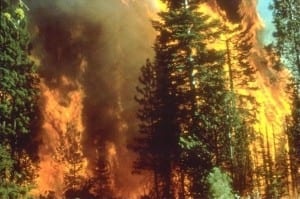
A long, complicated recovery faces farmers, ranchers and other rural residents who suffered losses in damaging late-summer wildfires that scorched large swaths of land. County Farm Bureaus and other organizations are working to ensure that people, livestock and pets have the support they need to overcome the disasters.
The Valley Fire in Lake County, which started Sept. 12, had burned about 76,000 acres and was about 70 percent contained as of Monday. The Butte Fire in Calaveras County had burned more than 71,000 acres and destroyed nearly 600 homes and 400 outbuildings. It was about 75 percent contained.
California Farm Bureau Federation field representative Gary Sack, who has been getting into the fire areas as safety permits, said hay is now arriving by the truckload to help feed livestock.
“Obviously, there are a lot of homes that have been burned in this summer’s fires; in Lake County, it’s more than 1,000 structures,” said Sack, who added that Lake County Farm Bureau President David Rosenthal’s home was one of the few standing in his part of Middletown.
Scores of Lake County Farm Bureau members lost property in the wildfires, Sack said, but the extent of the loss remains difficult to assess.
“As the fires calm down, we’ll see more clearly who has been affected,” he said. “However, we can see that even with good insurance, it’s going to be a long time before homes can be rebuilt. It will be a difficult winter for many families in the wildfire areas.”
Nationwide Insurance Co. said it has deployed mobile emergency claims offices in Lake and Calaveras counties to help speed claims processing for policyholders.
“Each member’s policy and claim is unique, and we work as quickly as possible to help them in their time of need,” company spokesman Christopher Stoller said. “Coverage is no different due to the cause of the loss, and we don’t treat commercial farms and ranches affected by wildfires differently than residential homes.”
Lake County Farm Bureau Executive Director Brenna Sullivan has been coordinating donations to help animals. Lake County volunteers set up a storage yard in a pear packing shed, donated by a county Farm Bureau member, and they’re gathering feed and hay there for distribution.
“After the chaos of the first days of the Valley Fire, we’ve been getting a lot of hay donations and we needed a place to store them,” Sullivan said. “As people are returning to their properties, they’re finding the fire burned through entire hay barns and grazing land has been burned up. We’re going to need tons of hay in coming months.”
The Sacramento County Farm Bureau delivered a load of much-needed supplies to Lake County last week, including horse halters, lead ropes and other animal-handling equipment. Other county Farm Bureaus, including those in Colusa, Glenn, Mendocino and Solano counties, are offering assistance and donations to the agricultural communities affected by the wildfires.
For example, Colusa County Farm Bureau Fire Relief is accepting donations at the county office in Colusa beginning Oct. 5, with weekly Friday deliveries planned to Lake County. More information on needed donation items is available on the Colusa County Farm Bureau Facebook page. An account also has been set up at Tri-Counties Bank in Colusa for cash donations. Checks should be made payable to “Farm Bureau Fire Relief.”
U.S. Department of Agriculture representatives from the Natural Resources Conservation Service said assessments of rural and agricultural properties in the burn areas in Lake, Napa, Amador and Calaveras counties continue. Early observations indicated need for many fence repairs, reseeding of meadows and hillsides, erosion control and rebuilding of barns and outbuildings, in addition to homes that have been lost, the agency said.
NRCS said there are several federal funding programs intended to protect watersheds and prevent erosion damage after wildfire disasters—the Emergency Watershed Protection Program, in particular, as well the Environmental Quality Incentives Program.
USDA officials said arrangements have been made with a ranch on the perimeter of the Valley Fire to take in animals, serve as a feeding station and allow for sorting, so animals can be returned to owners.
“People are taking hay and alfalfa pellets to this ranch so that the people inside the fire perimeter who have livestock can get something to feed their animals,” California NRCS representative Anita Brown said. “It’s very hard to go back and forth across the fire perimeter line, so this is a really vital service.”
Calls went out last week for livestock water troughs and veterinary supplies, because many animals that survived are injured and have gone days without water. Sack said actions are being taken to dispose of animals that perished in the fast-moving fires.
Although the Valley Fire struck in the middle of winegrape harvest, Lake County Winegrape Commission President Debra Sommerfield described the region’s grape growers and wineries as “an experienced and resilient farm community, committed to delivering the highest quality grapes despite these challenging conditions.”
Since the start of the fire, vineyard reservoirs have been used as a source of water for firefighting efforts.
Sommerfield announced a fundraising initiative last week—#LakeCountyRising—to help those affected by the Valley Fire. Participating organizations include the Lake County Winegrape Commission, Lake County Winery Association and Lake County Wine Alliance. Information on how to support this effort is online atwww.Facebook.com/LakeCountyRising.
The Napa Valley Vintners Association announced an initial grant of up to $250,000 to the UpValley Family Centers, based in Calistoga and St. Helena, to help Napa Valley residents affected by the fire with health and safety necessities such as food, clothing and security deposits for temporary housing.
Permission for use is granted from the California Farm Bureau Federation. Kate Campbell is an assistant editor of Ag Alert. She may be contacted at kcampbell@cfbf.com.









